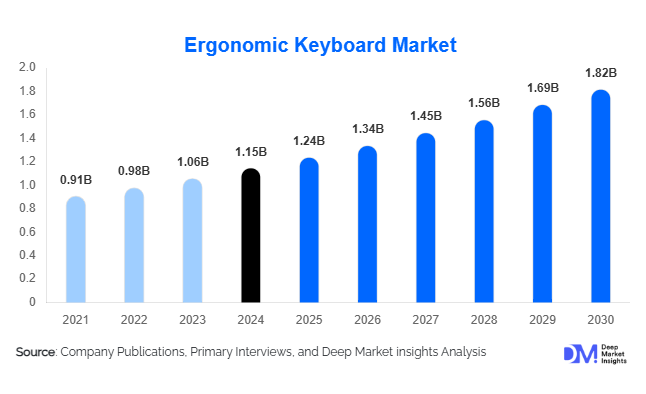Summary Answer
The ergonomic keyboard market is currently led by Logitech and Microsoft, holding top positions thanks to their broad product offerings and strong presence in both consumer and enterprise sectors. Other notable brands include Kinesis, Goldtouch, Fellowes, Adesso, Perixx, Matias, Maltron, and Keychron each catering to different user needs from office workers to serious typists and accessibility users.
The global ergonomic keyboard market size was valued at USD 1.15 billion in 2024 and is projected to grow from USD 1.24 billion in 2025 to reach USD 1.82 billion by 2030, growing at a CAGR of 8% during the forecast period (2025-2030). The growth of the market is attributed to rising awareness of workplace health risks and the increasing adoption of technological advancements and customization features that enhance user comfort and productivity.
1. Why Is Logitech Leading the Ergonomic Keyboard Market?
-
Market Presence: Logitech dominates the space with a diverse product lineup that appeals to a wide audience, including office users, creatives, and gamers.
-
Top Models: The Logitech ERGO K860 is one of the most recognized ergonomic keyboards on the market, praised for its curved design, wrist support, and easy multi-device switching.
-
Affordability: Even their entry-level models, like the Logitech Wave Keys, offer ergonomic benefits at a more accessible price point.
2. Microsoft: Workplace Integration and Reliability
-
Enterprise Favorite: Microsoft’s ergonomic keyboards are a staple in many corporate environments, thanks to their seamless compatibility with Windows systems and durable design.
-
Popular Products: Keyboards like the Sculpt Ergonomic, Microsoft Ergonomic Keyboard, and Surface Ergonomic Keyboard feature split layouts and built-in wrist rests.
-
New Developments: In 2025, Microsoft collaborated with Incase to launch a compact ergonomic keyboard that includes modern features like multi-device connectivity and a dedicated Copilot AI key.
3. Kinesis: The Power User’s Choice
-
Niche Focus: Kinesis specializes in deeply ergonomic keyboards for professionals who type for long hours and want advanced customization.
-
Standout Models: Their Advantage2 and Freestyle2 keyboards are known for their split designs, tenting capabilities, and programmable layouts.
-
Why Users Love It: The emphasis on comfort, muscle memory, and customization makes Kinesis a top pick for coders, writers, and anyone with repetitive strain injuries.
4. Other Noteworthy Brands in the Market
-
Goldtouch: Offers adjustable split keyboards that are ideal for travel or shared workstations. Known for flexibility and portability.
-
Adesso: Targets the budget market with ergonomic models like the Tru-Form 150, sometimes including extras like built-in touchpads or RGB lighting.
-
Fellowes & Perixx: Both provide basic ergonomic designs suited for general office environments, often found in big-box and B2B retail.
-
Matias: Focuses on mechanical ergonomic keyboards, such as the Ergo Pro, offering tactile feedback and tented layouts for professionals.
-
Keychron: While not a traditional ergonomic brand, Keychron’s modular, mechanical keyboards are gaining popularity among users who want tactile comfort and customization.
-
Maltron: Known for highly specialized ergonomic keyboards designed for users with disabilities or those recovering from RSI. Their 3D keyboards are engineered for extreme comfort and minimal hand movement.
5. What’s Driving Their Success?
-
Innovative Design: Ergonomic keyboard leaders prioritize comfort-driven features like split layouts, curved key wells, tenting, and negative tilt.
-
Tailored Segments: From general consumers to gamers and specialized professionals, brands are designing for specific user needs rather than a one-size-fits-all approach.
-
Adapting to Remote Work: Lightweight, wireless, and compact ergonomic keyboards are now essential in the home office boom something many brands are capitalizing on.
-
Increased Awareness: Growing awareness around repetitive strain injuries, carpal tunnel syndrome, and overall desk ergonomics is fueling long-term demand.

